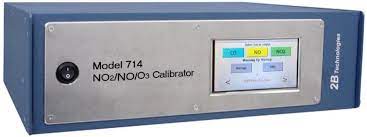Instrument Support Level 2
2B Technologies Model 714 NO2/NO/O3
N/A
£15,000
43 cm x 37 cm x 14 cm, 7.5kg
42cm x 59cm x 40x cm, 15kg
£20
Calendar

714 NO2/O3 Calibration Source
Calibrated concentrations of O3 are produced by photolysis of oxygen in scrubbed ambient air, and calibrated concentrations of NO are produced by photolysis of nitrous oxide, N2O, via a patented process,
N2O + light –> N2 + O*
O* + N2O –> 2 NO
where O* is electronically excited oxygen atoms. In addition, calibrated concentrations of NO2 are produced by gas phase titration (GPT) of NO with O3 using the same method as conventional GPT NO/NO2 calibrators.
NO2 0-500ppb
O3 0-500ppb
NO 0-1000ppb
30 second response time
Nitrous oxide is provided to instrument by disposable 8 or 16 oz cartridges typically used for making whipped cream, no cylinders needed.
Precision: Greater of 2.0 ppb or 2.0% of NO or O3 concentration
Response Time: >30 seconds
Instructions for use will be provided. The instrument requires cartridges of N2O which are commercially available. Air is pulled through the unit and NO2 (NO, O3) are generated at atmospheric pressure ready for delivery direct to the instruments. Concentrations in the range 0-500ppbV are possible. Flow rate for delivery 2.5L/min.
The ‘calibrator’ is referenced against global atmosphere watch referenced standards in the COZI Lab before and after deployment. NO2 is not stable within cylinders and therefore calibration of field instruments is complicated to perform in the field. This instrument provides a mobile calibration of NO2 (and also of O3 and NO).
Consumables
The user will need to supply (otherwise will be charged for):
- N2O canisters 8/16 oz
Costs
- Instrument Insurance
- This system must be insured by the user for £15K and covers loss, theft or damage to the instrument: damage is that over and above general wear and tear. The system has been designed to be rugged and autonomous. Even so, the end-user must respect the fact that the system is a precision optical instrument that must be treated with great care.
- The user is responsible for the instrument from the time it leaves the AMOF to the time it is returned and signed off as in an acceptable operating condition by the IS: this will be done as soon as is possible on its return.
- Public Liability Insurance
- The AMOF is not liable for any damage or injury arising from the deployment or operation of this instrument when unattended by the IS.
- Shipping Expenses
- The user is liable for all costs arising from the shipping of the instrument both to and from a deployment.
- IS T&S
- The user is responsible for coving the travel and subsistence expenses of the IS while attending the instrument.
Shipping
The system when packed ready for shipping consists of a single box:
- Shipping dimensions:
- 44 cm (W) X 59 cm (H) X 79 cm (D)
- Shipping weight:
- 20kg
The calibrator should be operated from an air-conditioned laboratory, measurements taken at atmospheric pressure.
Manual handling
- Do not attempt to lift the analyzer by the cover or other external fittings.
- Cables and sample tubing kept away from pathways; held overhead height if necessary.
- Walkways kept free of clutter and access to exit kept clear.
Electric safety
- Check calibrator casing, and cables are in good condition before switching on.
- Attach all cables to analyser before switching on at the mains. All equipment electrical safety tested.
Attended operation
- There is no requirement for the system to be attended during operation from a safety standpoint.
7.5kg, 43 cm x 37 cm x 14 cm
Power
120/240 V AC with 5-amp power pack, or 12 V DC
Run, O3 Channel: 0.91-2.79 A at 12 V, 11-34 watt
Run, NO Channel: 1.16-3.10 A at 12 V, 14-38 watt
Warmup Max: 3.38 A at 12 V, 40.6 watt (warmup)
Operation temperature
- 5 °C to 40 °C in non-condensing environments
No data required for CEDA, all calibration data should be made available to Katie.read@york.ac.uk for AMOF archiving
